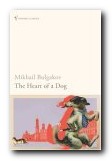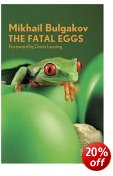major works in English translation
Apart from the relatively straightforward and restrained Checkhovian style of his early work, A Country Doctor’s Notebook, most of Mikhail Bulgakov’s writing is characterised by a florid prose style, rich images, and startling metaphors. He also plays freely with science fiction, political allegory, and sudden shifts into the absurd.
You might keep in mind that almost all of what he wrote was either censored, banned, or simply not published in his own lifetime. Even though some of his work was popular when it appeared in the 1920s, his reputation as a major Russian writer has only been established since his writing has been gathered together and published in the post-1960s.
 The Heart of a Dog (1925) A rich, successful Moscow professor befriends a stray dog and attempts a scientific experiment by transplanting into it the testicles and pituitary gland of a recently deceased man. A worryingly human animal is then turned on the loose, and the professor’s hitherto respectable life becomes a nightmare beyond endurance. An absurd and superbly comic story, this classic novel can also be read as a fierce parable of the Russian Revolution.
The Heart of a Dog (1925) A rich, successful Moscow professor befriends a stray dog and attempts a scientific experiment by transplanting into it the testicles and pituitary gland of a recently deceased man. A worryingly human animal is then turned on the loose, and the professor’s hitherto respectable life becomes a nightmare beyond endurance. An absurd and superbly comic story, this classic novel can also be read as a fierce parable of the Russian Revolution.
![]() Buy the book from Amazon UK
Buy the book from Amazon UK
![]() Buy the book from Amazon US
Buy the book from Amazon US
 Black Snow: A Theatrical Novel (1920s) When Maxudov’s bid to take his own life fails, he dramatises the novel whose failure provoked the suicide attempt. To the resentment of literary Moscow, his play is accepted by the legendary Independent Theatre and he plunges into a vortex of inflated egos. With each rehearsal more sparks fly and the chances of the play being performed recede. This is a back-stage novel and a brilliant satire on his ten-year love-hate relationship with Stanislavsky and the Moscow Arts Theatre.
Black Snow: A Theatrical Novel (1920s) When Maxudov’s bid to take his own life fails, he dramatises the novel whose failure provoked the suicide attempt. To the resentment of literary Moscow, his play is accepted by the legendary Independent Theatre and he plunges into a vortex of inflated egos. With each rehearsal more sparks fly and the chances of the play being performed recede. This is a back-stage novel and a brilliant satire on his ten-year love-hate relationship with Stanislavsky and the Moscow Arts Theatre.
![]() Buy the book from Amazon UK
Buy the book from Amazon UK
![]() Buy the book from Amazon US
Buy the book from Amazon US
 A Country Doctor’s Notebook (1925) With the ink still wet on his diploma, the twenty-five year old Dr Mikhail Bulgakov was flung into the depths of rural Russia which, in 1916-17, was still largely unaffected by such novelties as the motor car, the telephone or electric light. How his alter-ego copes (and fails to cope) with the new and often appalling responsibilities of a lone practitioner in a vast country practice – in blizzards, pursued by wolves and on the eve of Revolution – is described in Bulgakov’s delightful blend of candid realism and imaginative exuberance.
A Country Doctor’s Notebook (1925) With the ink still wet on his diploma, the twenty-five year old Dr Mikhail Bulgakov was flung into the depths of rural Russia which, in 1916-17, was still largely unaffected by such novelties as the motor car, the telephone or electric light. How his alter-ego copes (and fails to cope) with the new and often appalling responsibilities of a lone practitioner in a vast country practice – in blizzards, pursued by wolves and on the eve of Revolution – is described in Bulgakov’s delightful blend of candid realism and imaginative exuberance.
![]() Buy the book from Amazon UK
Buy the book from Amazon UK
![]() Buy the book from Amazon US
Buy the book from Amazon US
 The Fatal Eggs (1924) Professor Persikov discovers a new form of light ray whose effect is to accelerate growth in primitive organisms. But when this ray is shone on the wrong batch of eggs, the Professor finds himself both the unwilling creator of giant hybrids, and the focus of a merciless press campaign. For it seems the propaganda machine has turned its gaze on him, distorting his nature in the very way his ‘innocent’ tampering created the monster snakes and crocodiles that now terrorise the neighbourhood. An inspired work of science fiction and a biting political allegory.
The Fatal Eggs (1924) Professor Persikov discovers a new form of light ray whose effect is to accelerate growth in primitive organisms. But when this ray is shone on the wrong batch of eggs, the Professor finds himself both the unwilling creator of giant hybrids, and the focus of a merciless press campaign. For it seems the propaganda machine has turned its gaze on him, distorting his nature in the very way his ‘innocent’ tampering created the monster snakes and crocodiles that now terrorise the neighbourhood. An inspired work of science fiction and a biting political allegory.
![]() Buy the book from Amazon UK
Buy the book from Amazon UK
![]() Buy the book from Amazon US
Buy the book from Amazon US
 The Master and Margarita (1940/1973) is a wonderful mixture of realism and fantasy which offers a satirical view of communist Russia. The story involves the arrival of the Devil into Moscow, interspersed with chapters dealing with Pontius Pilate and the crucifixion of Jesus Christ, plus other sections related to an artist and his relationships with his art and his lover. All three layers of the story are blended with spellbinding imaginative force. The novel is a multilayered critique of the Soviet society in general and its literary establishment specifically. It begins with Satan visiting Moscow in 1935, joining a conversation of a critic and a poet, busily debating the existence of Jesus Christ and the Devil. It then evolves into a whole scale indictment of the corruption, greed, narrow-mindedness, and widespread paranoia of Stalinist Russia. Banned but widely read, the novel firmly secured Bulgakov’s place among the pantheon of the greatest of Russian writers.
The Master and Margarita (1940/1973) is a wonderful mixture of realism and fantasy which offers a satirical view of communist Russia. The story involves the arrival of the Devil into Moscow, interspersed with chapters dealing with Pontius Pilate and the crucifixion of Jesus Christ, plus other sections related to an artist and his relationships with his art and his lover. All three layers of the story are blended with spellbinding imaginative force. The novel is a multilayered critique of the Soviet society in general and its literary establishment specifically. It begins with Satan visiting Moscow in 1935, joining a conversation of a critic and a poet, busily debating the existence of Jesus Christ and the Devil. It then evolves into a whole scale indictment of the corruption, greed, narrow-mindedness, and widespread paranoia of Stalinist Russia. Banned but widely read, the novel firmly secured Bulgakov’s place among the pantheon of the greatest of Russian writers.
![]() Buy the book from Amazon UK
Buy the book from Amazon UK
![]() Buy the book from Amazon US
Buy the book from Amazon US
© Roy Johnson 2004